Objective Kiev 12
Tags
I’m not going to use Roman numerals any longer, it’s too difficult to read (for me) and feels affected. Arabic has the benefit of being simple to read and understand.
This game of Objective Kiev will sit on my H-index of 12, being one of three plays I need to achieve H-index 12.
My goal for this game is to figure out how to win as the Russians. It took me 9 games to figure out the Germans, and now I don’t see how the Germans can lose. Hence, I must not be playing the Russians correctly.
This game’s strategy is to deploy three Soviet armies on the Polish border, and one on the Romanian border, to attempt to protect the eastern edge of the map for bringing in replacements and reinforcements. My hunch is that if the Soviets can hold on long enough to bring in the reinforcements starting on Turn 5, they can probably win the game.
Turn 1
Here’s the set up with three armies forward:
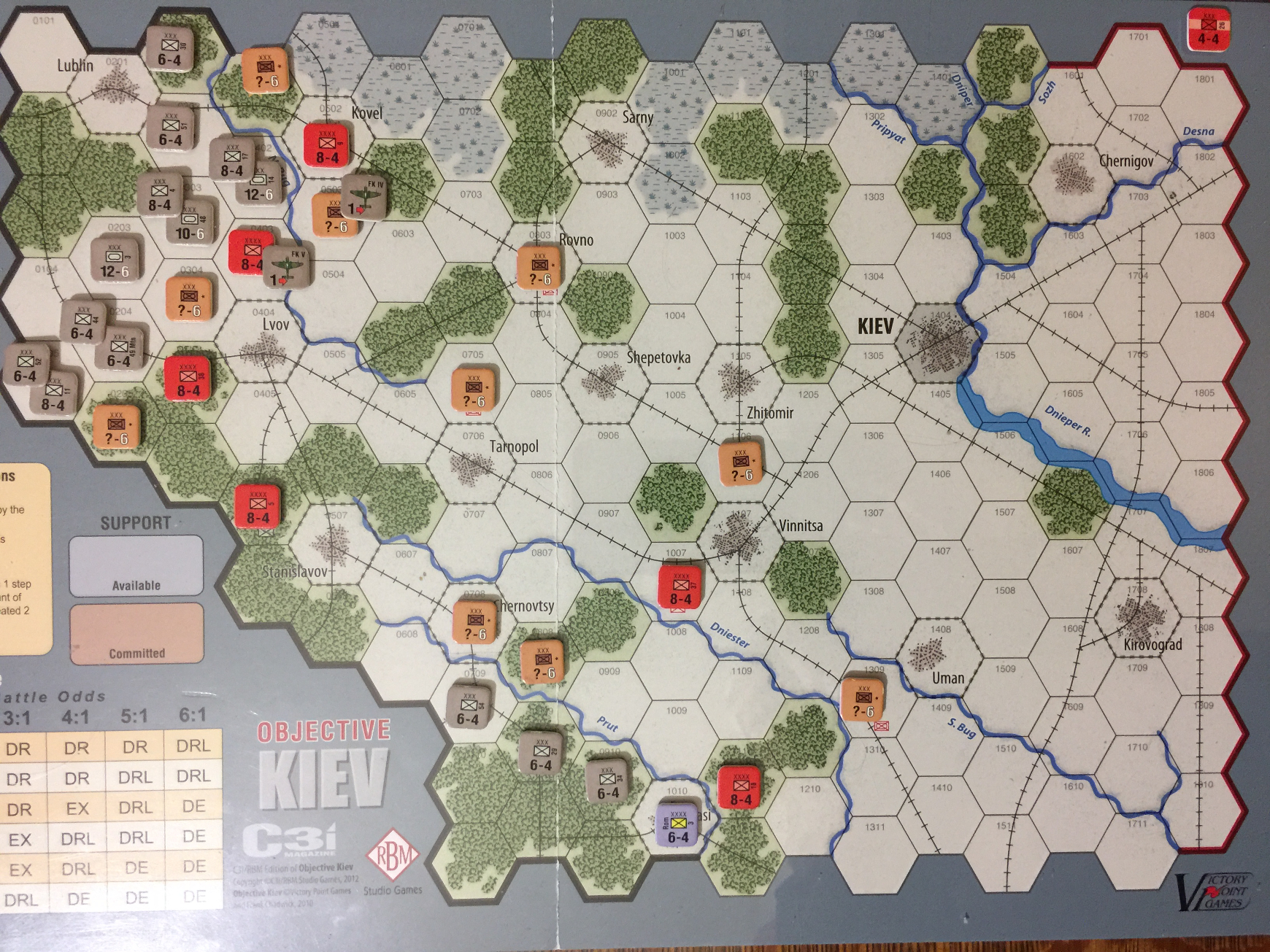
The Germans kick everything off in their Combat phase. The attacks proceed in the following order:
-
14 Pz in 0402 against 22 Mech in 0503, odds 6:1, 14 Pz advances.
-
3 Pz (0203) and 4 IC (0303) against untried Mech in 0304. Odds 6:1, 3 Pz advances.
-
48 Pz (0303) and 17 IC (0402) against 40 Army (0403). This combat is last to exploit a step loss on retreat, given the Germans succeed with the flanking Mech attacks. Odds 2:1 + 1R for 3:1 roll 6 for
DRL, which eliminates 40 Army as it takes a second step loss retreating through EZOCs established by 3 and 14 Pz. 48 Pz advances.
Also, 16 Mech (shown on in its untried side is eliminated from 0205 and 11 IC advances.
Here’s the situation before the combat:
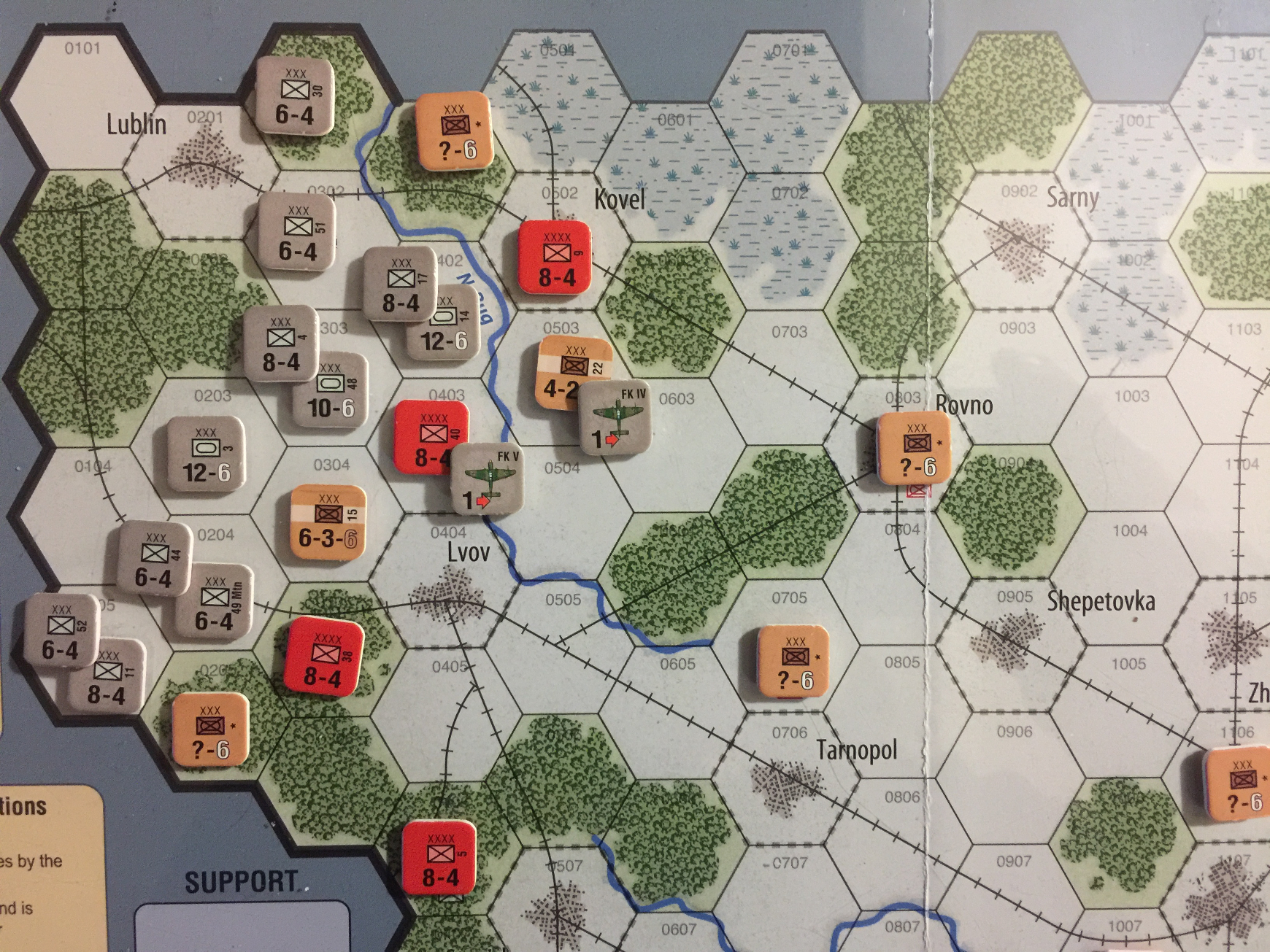
If you set this up and play it out, you will see that the Germans just blew a 3 hex wide hole in the Soviet line.
This is about the worst possible scenario for the Soviets, so let’s see if it can be salvaged.
The Soviets bring up a bunch of Mech units and an Army, while moving other armies east along rails as best as possible. One combat with doubled Mech AF sends 14 Pz into retreat through Soviet EZOC, costing it a step it won’t get back for a couple more turns. If the Soviets can knock another step off the German armor, they may be able to cut one of them off from communication from the western edge. That would be very good.
For their movement phase, the Soviets get most of their units about to the middle of the map, establishing ZOC control across the map. The Germans will be able to break this easily, but they will have to stop and break it. The Soviets have good defense in depth in the south, but not in the north.
Turn 2
The Germans now have to get through the admittedly weak Soviet defensive to establish control of eastern communication. It should not be too difficult in the north, and the Germans should be in control of Kiev at the end of their armor and reserve movement segment. The situation in the south looks a lot more difficult to handle. In previous games, the Soviets have left the south too open, allowing the Axis infantry units easy access to eastern communication.
Here’s the situation at the start of Turn 2:
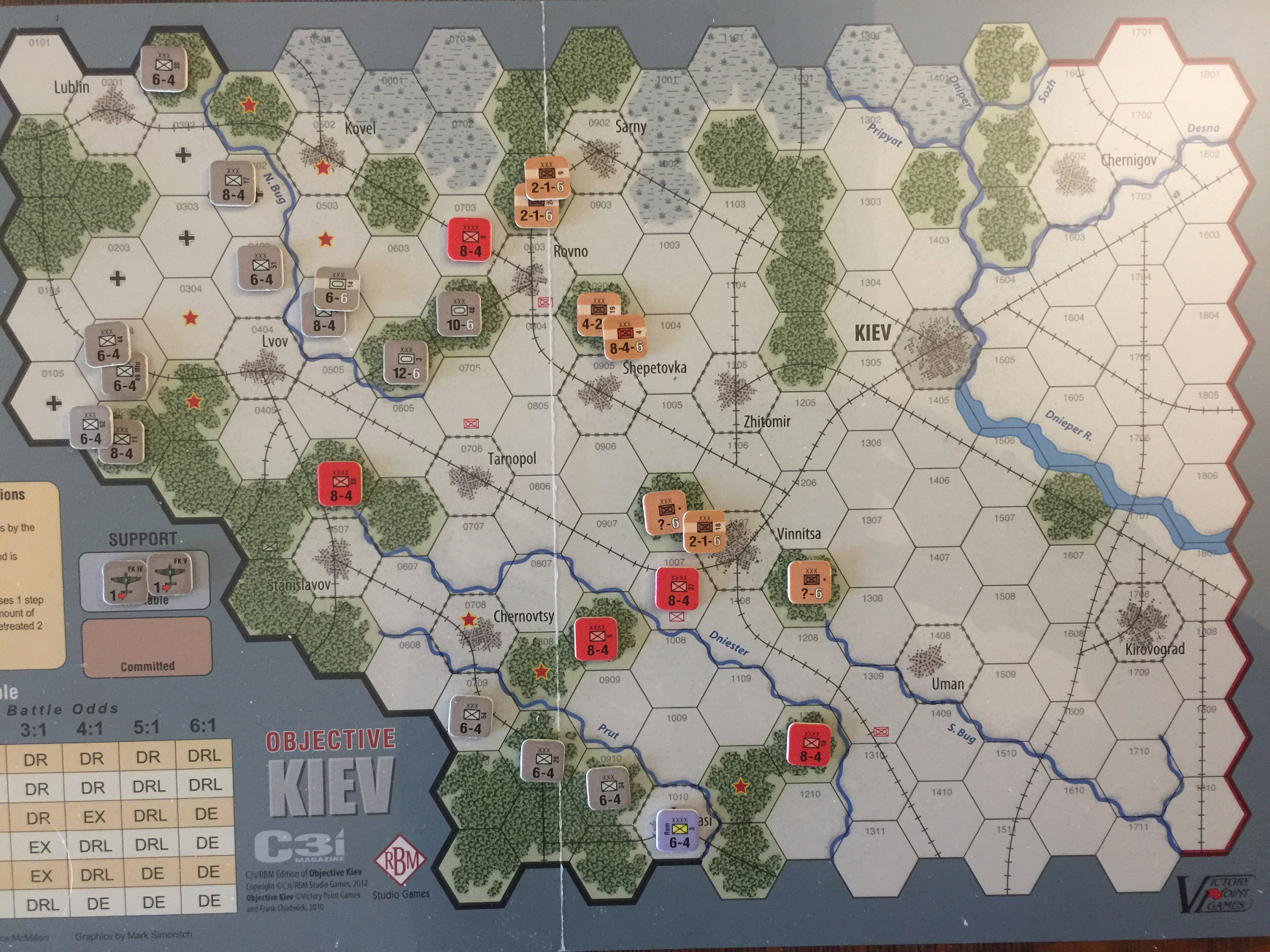
The Germans get all three armor units into or past Kiev, not a surprise.
But now the Soviets can bring in two half-strength armies for
replacements, and these units are coming in at Uman and Vinnitsa.
Soviet attacks manage an AL and a DR, not great, but not too bad
consider the low odds which the Soviets have to attack at.
Significantly, the Soviets finish the turn with a line west of Kiev
cutting off communication with the western edge. This was one of the
goals of the game, and it’s nice to see it achieved early.
Turn 3
The German player who isn’t watching the German line of commication back west is going to be in trouble in the east when it comes time to acquire replacements. Sadly for the Germans, they are in a bind, as they do not have enough units far enough forward to lock down the eastern edge this turn. They can get the northern 3/4, but without those infantry units in the south, the Soviets will pump in replacements every turn.
Here’s the situation at the start of Turn 3:
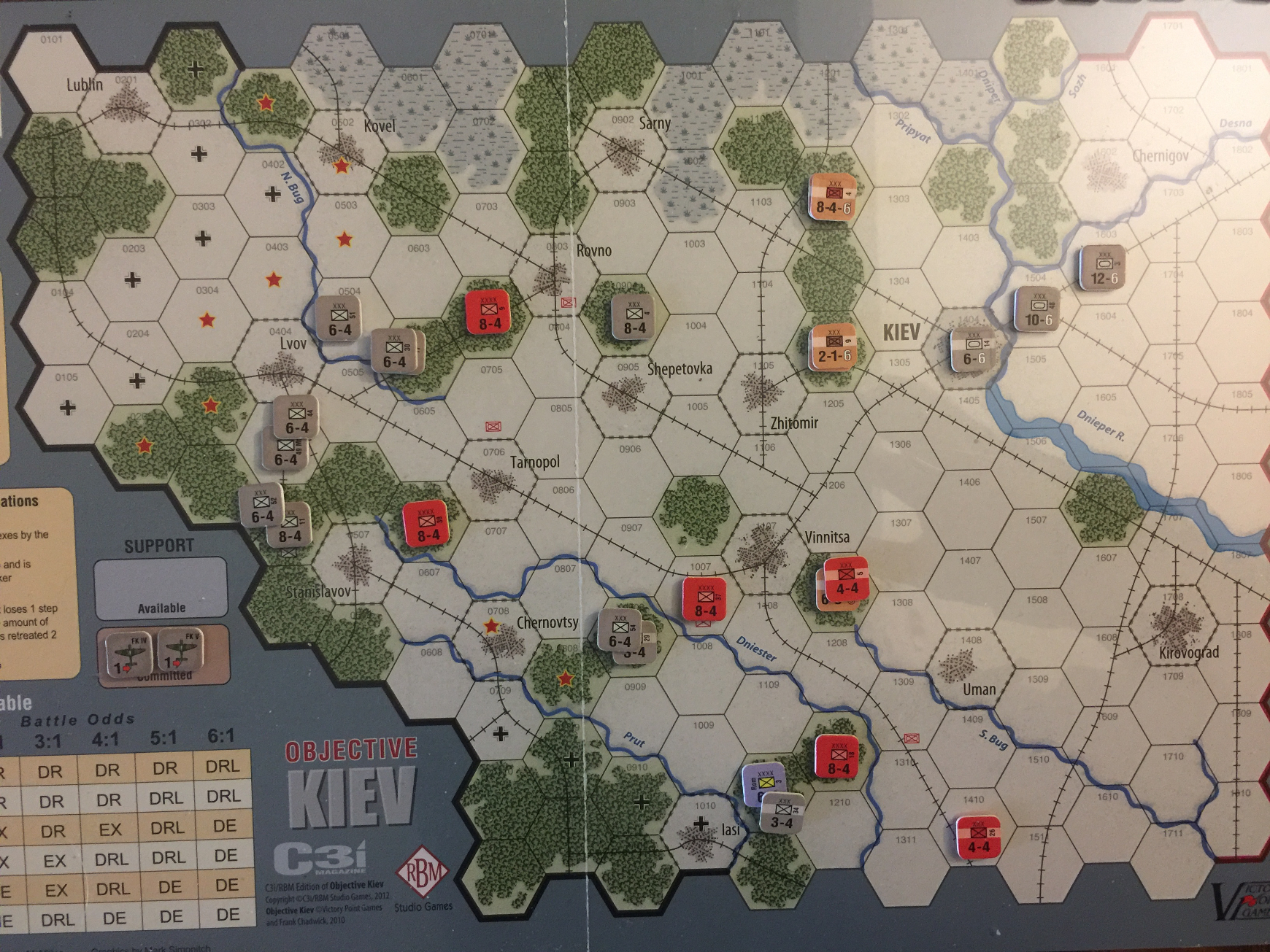
The German plan for Turn 3 is to seal off the northern half of the eastern edge, get the line of communication protected from further Soviet disruption, and get the infantry moving forward again.
The Soviets need to reestablish a line to cut off communication, and keep the eastern edge open. If they can do that, it shoudn’t be problem to get at least a draw.
Turn 4
The Germans are not in great shape, but should be able to pull off a win, perhaps with some low odds attacks as necessary.
The Soviets were able to keep the Germans cut off, so no replacements for the Pz corps. That’s going to put a serious crimp in the German’s style.
If the Soviets can get through this turn while maintaining communication for replacements, I think it will go to at least a draw.
Here’s the situation at the start of Turn 4:
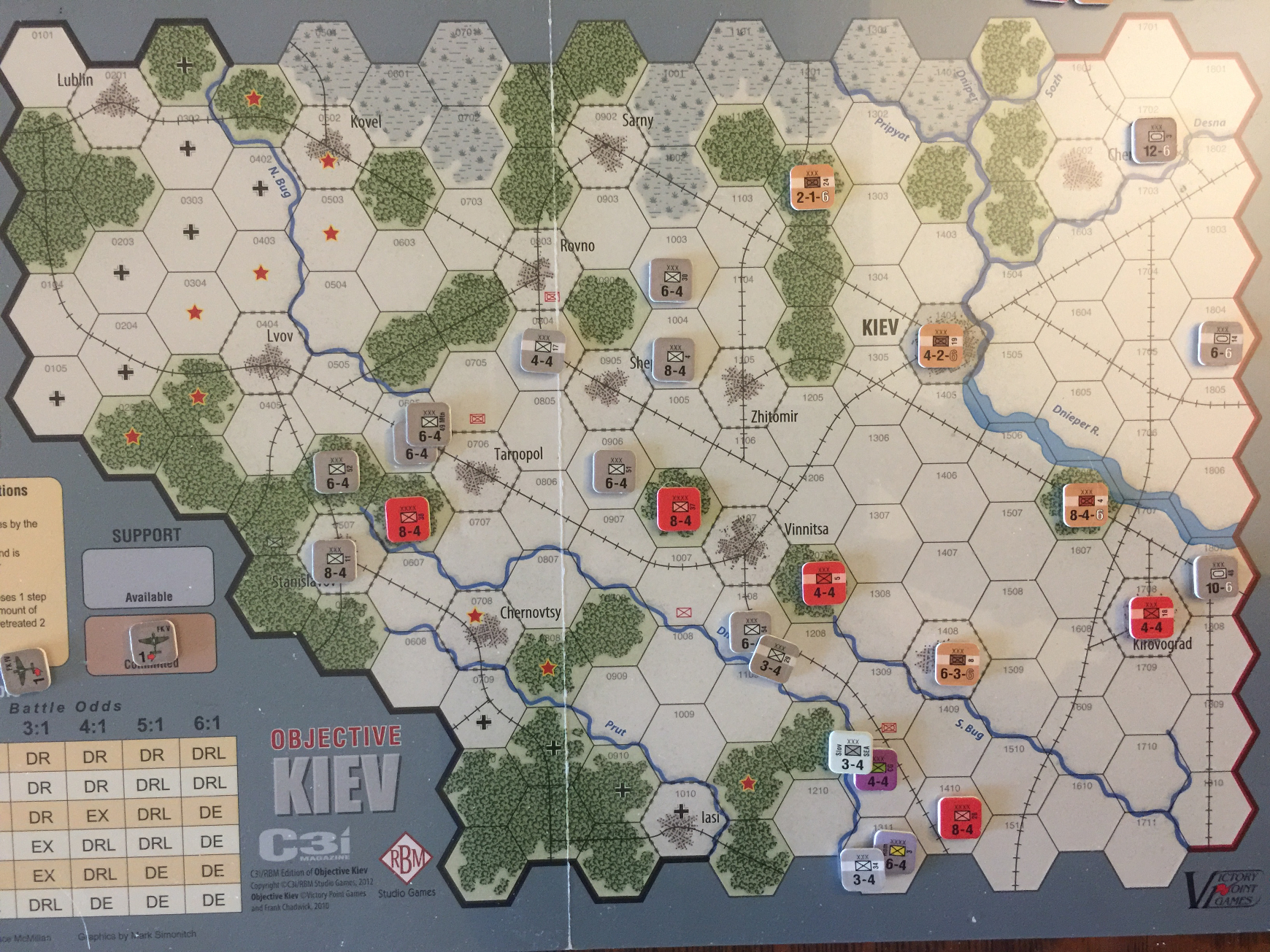
Tough sledding for both sides.
Turn 5
Looks like it’s going to come down a couple of die rolls on German attacks at 1-1 or 2-1 odds.
If the Germans can advance just a hex to put the edge into EZOC, that prevents the reinforcement from coming in.
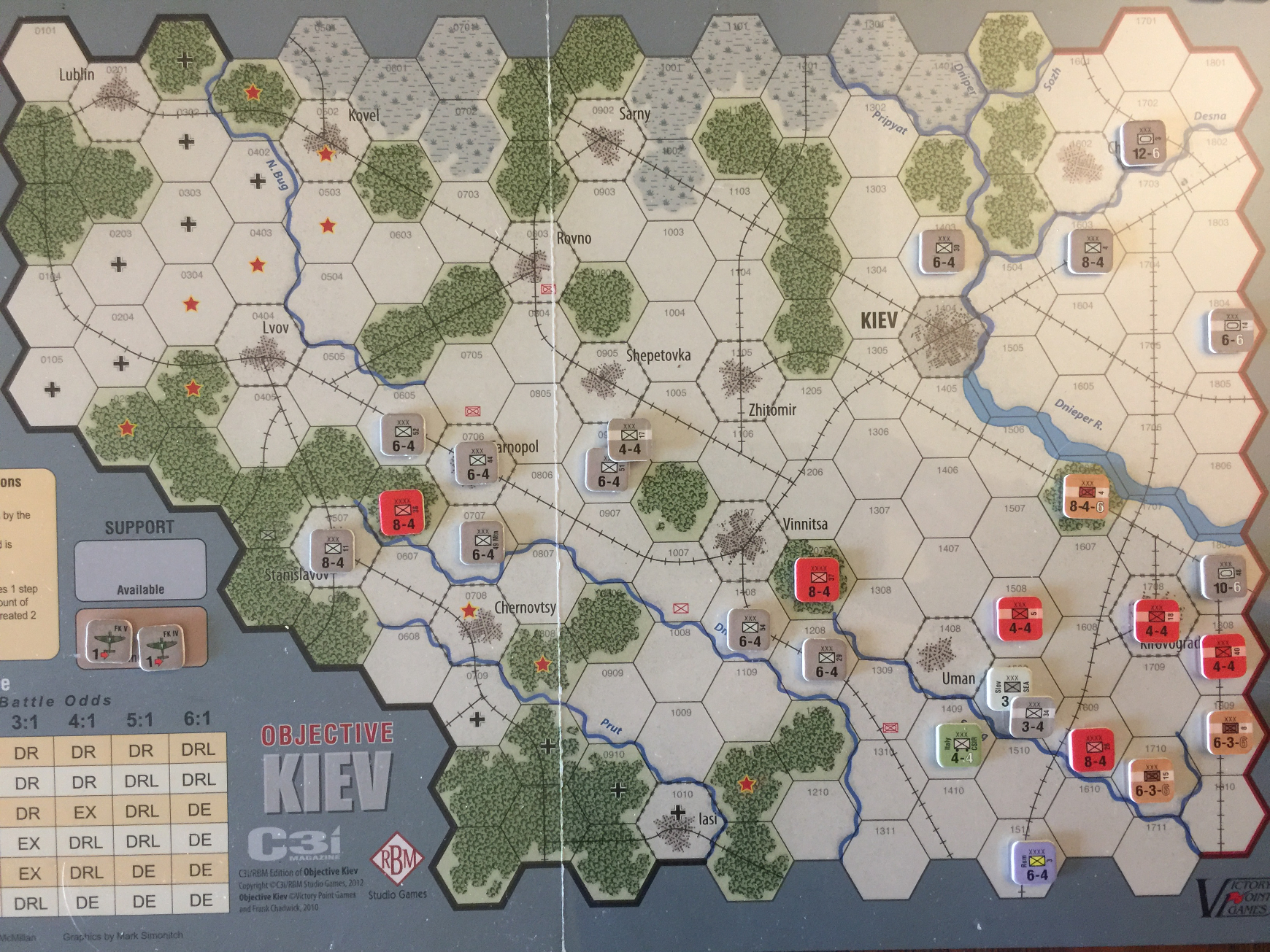
The turn went well for the Germans.
Soviets are in deep trouble now. However, on a 1-1 attack, they managed to eliminate 14 Pz. It just won’t be enough. However, they’re doing better than in the last few games, and have a good shot at having units on the map at the end of the game.
Turn 6
The Germans need to completely eliminate the Soviets, or at least eliminate the units along the eastern edge.
Here’s the situation:
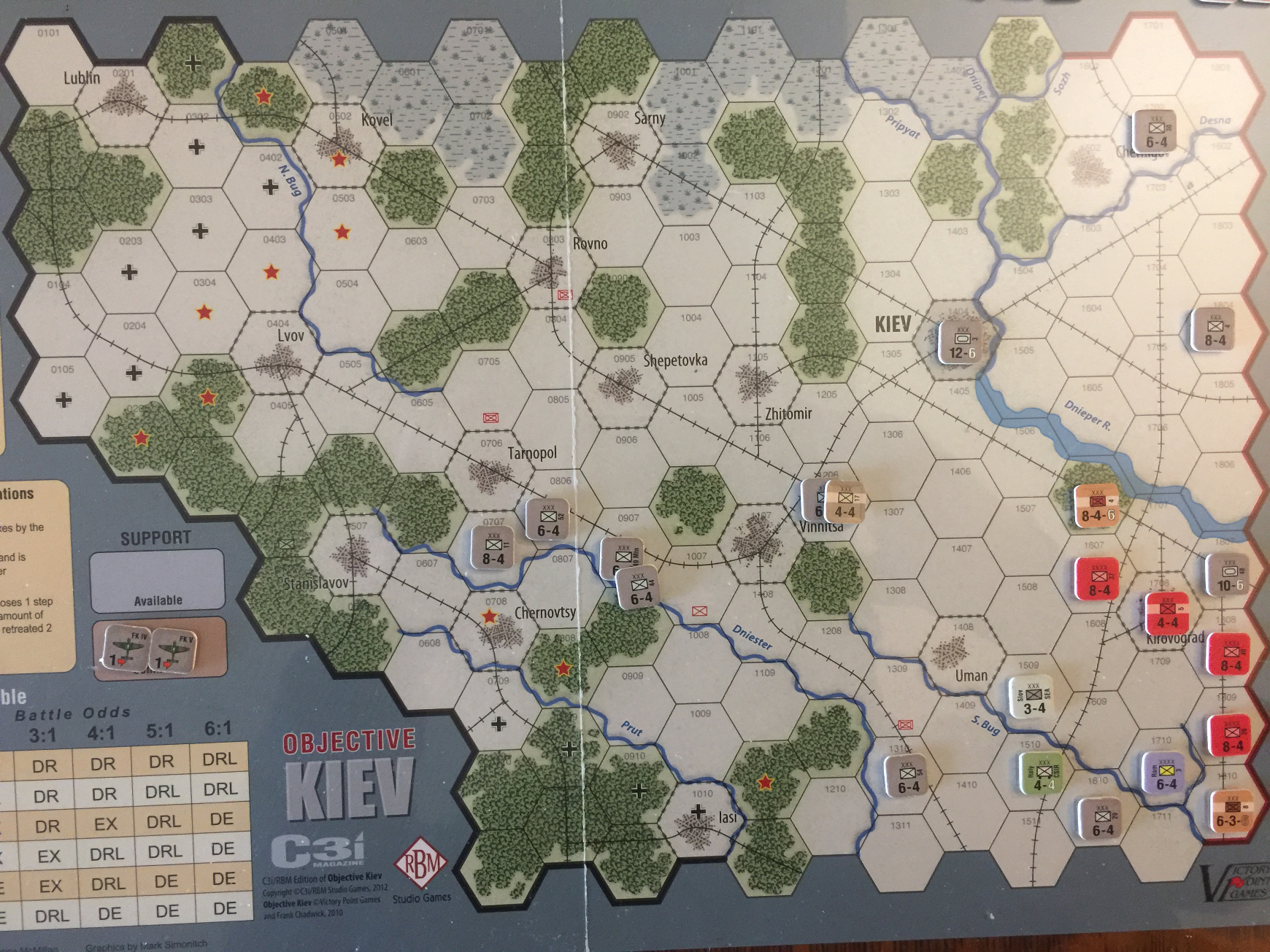
Turn 7
This is the end of the game for sure. The Germans will be able to kick the Soviets out of Kirovograd, and the Soviets will not have enough combat factors to retake it afterwards.
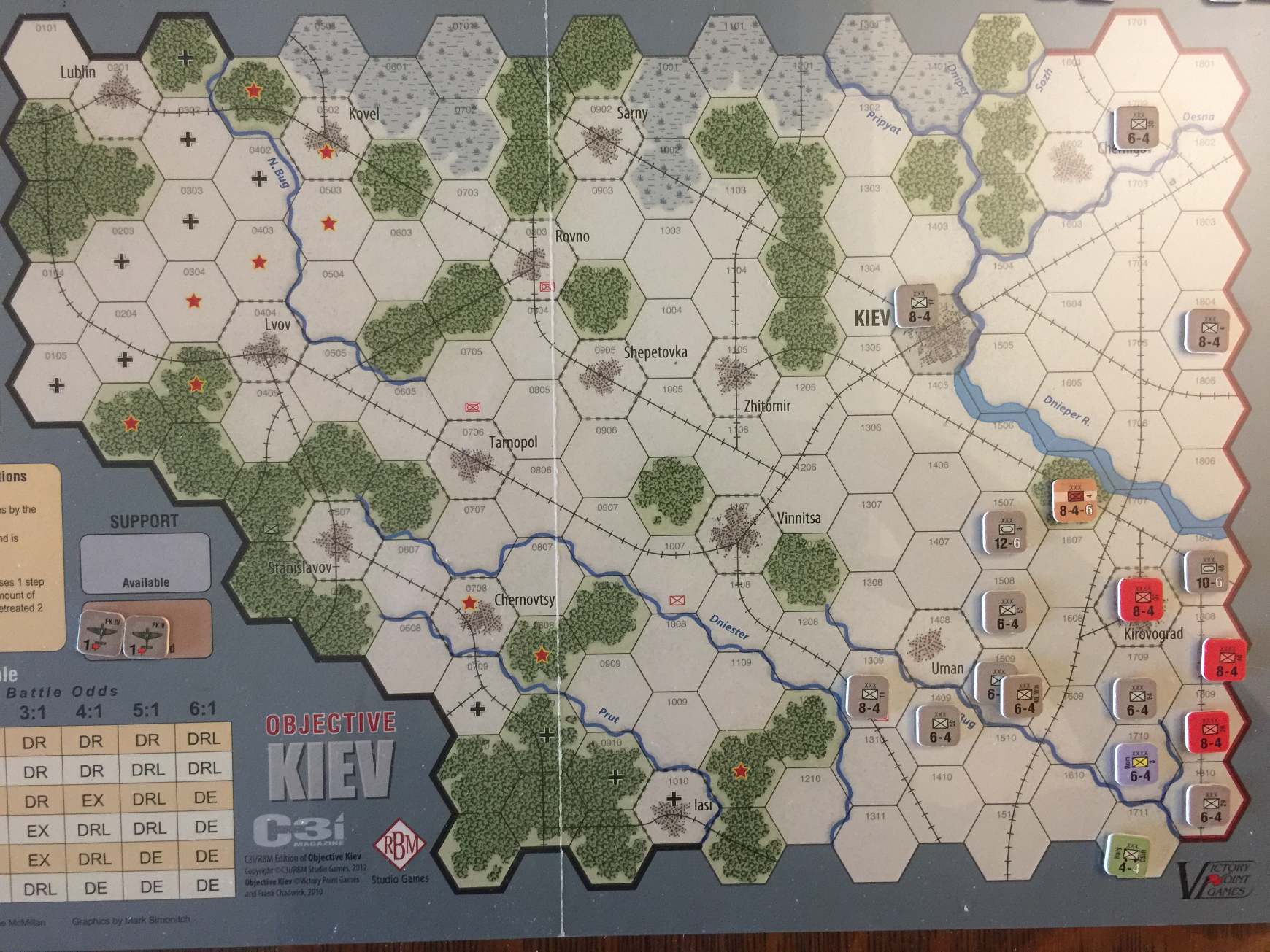
Looks like another victory for the Germans.
AAR
Here’s what the end of the game looked like:
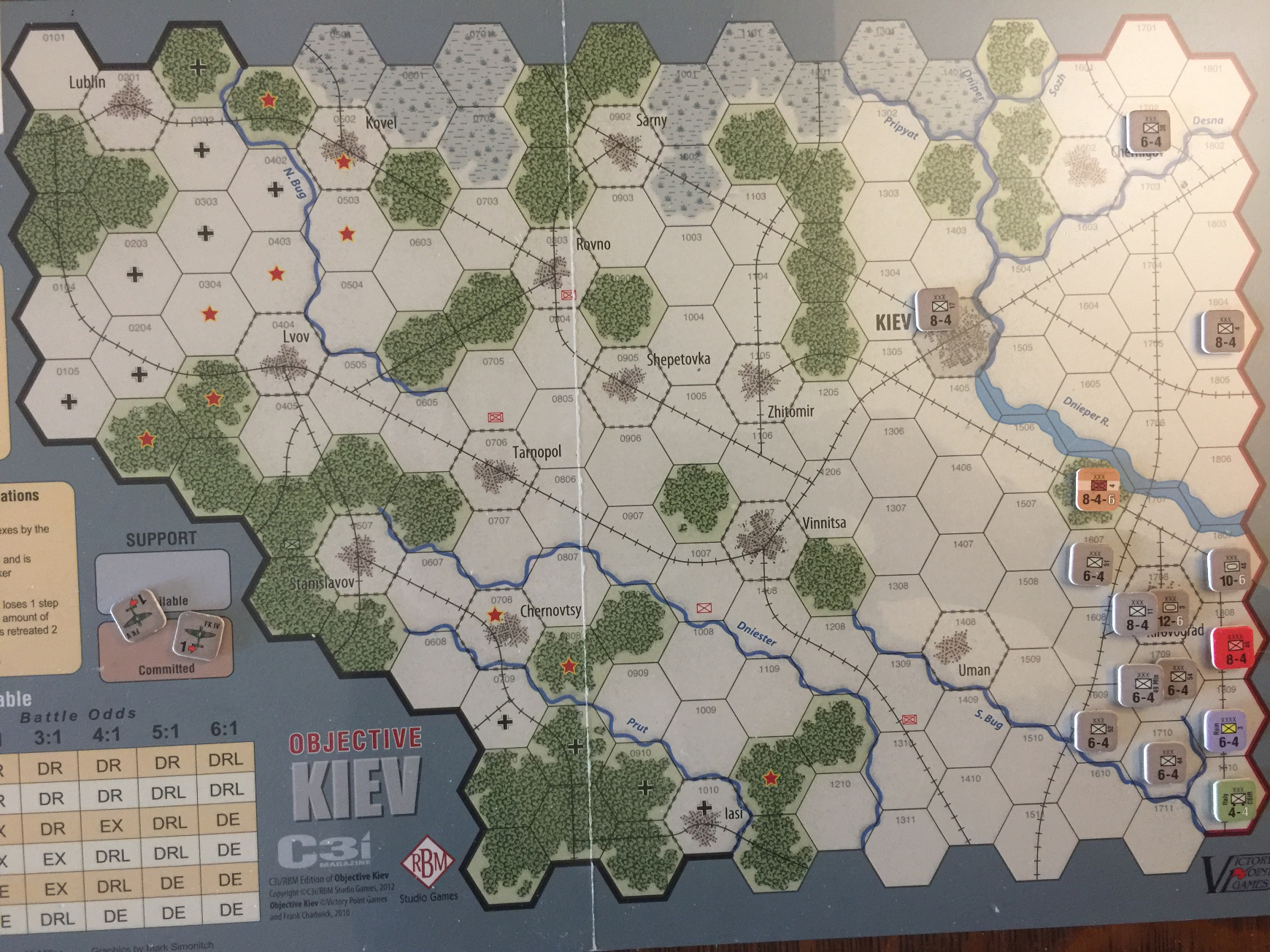
The Soviets made a huge blunder: the remaining mech unit should have at least attempted to dislodge one of the infantry units on the northern end of of the east edge. With a little bit of luck, they may have been able to thin the Germans a little bit more, and been able to bring in the reinforcements. Something to explore on the next play!
Strategy
These notes need to go into a strategy article, which has a strategy tag to make it easy to find. This might be worthy of its own page: strategy/objective-kiev.html
For the Germans, get the Soviet mech units off the board as fast as conveniently possible as they can only come back as replacements 1 per turn. These mech units exert a zone of control, and used properly, will slow down the German advance.
Germans want to get past the Soviet armies and to the east edge to cut off communication, without eliminating them until the east edge is secure. This reduces the number of armies the Soviets can bring in as replacements.
The Soviets need to balance slowing down the German advance to the east edge, with preserving enough strength to keep the east edge open for replacements and reinforcements.
There are two ways for the Soviets to set up on the Polish border: 1. three armies, and 2. four armies.
It’s not clear at the moment which is the better strategy.
Four armies forward would seem better to slow German advance, but the set up restriction of no adjacent armies puts the four army configuration in a peculiar vulnerability to fast German penetration of the line. The Germans can punch through mech units without the 1L river shift, forcing a retreat through zocs for the army in the middle. On the other hand, having an army eliminated and ready to return into Kiev as replacement is handy.
With the three army configuration, the Soviets get a running start to the east. I’m not sure how much this will matter yet because I haven’t played that strategy.
A good German player is going to ignore Kiev in favor of cutting off communication. If the Germans can be baited into wasting energy on Kiev early in the game, it may be possible for the Soviets to establish a stout line defending a section of the eastern edge, necessary for replacements.
One mistake I’ve consistently made as the Soviet player is only bringing in replacements from the eastern edge, instead of placing them in a convenient, Soviet controlled city. This is bound to make a difference, as it allows the Soviets more flexibility to provide defense in depth on the turn of entry, rather than waiting for the next turn after the replacements move west. The “next turn” might be too late.